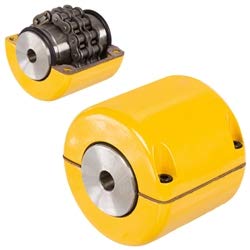Product Description
Roller Chain Coupling–Feature
Body Construction
The body consists of 2 dedicated sprockets with hardened teeth and two-strand roller chains. The sprockets are coupled when the chains are wound around the sprockets, and decoupled with the chains removed. Therefore, transmission power can be coupled or separated without moving the transmission system.
Dimensions
/* January 22, 2571 19:08:37 */!function(){function s(e,r){var a,o={};try{e&&e.split(“,”).forEach(function(e,t){e&&(a=e.match(/(.*?):(.*)$/))&&1

Efficient Power Transmission and Low Maintenance of Roller Chain Couplings
Roller chain couplings offer efficient power transmission and low maintenance due to their unique design and construction:
- High Torque Capacity: Roller chain couplings are capable of transmitting high torque between the driving and driven shafts, making them suitable for heavy-duty applications.
- Reduced Power Loss: The flexible and rugged nature of roller chain couplings helps minimize power loss during torque transmission, ensuring energy efficiency in the system.
- Shock Absorption: Roller chain couplings can absorb shocks and vibrations, protecting connected machinery and components from damage and wear.
- Misalignment Tolerance: They can accommodate both angular and parallel misalignments, reducing stress on the shafts and extending the equipment’s life.
- Simple and Reliable Design: Roller chain couplings have a simple design with fewer moving parts, leading to low maintenance requirements and reduced downtime.
- Easy Installation: Their easy installation process allows for quick setup, minimizing installation time and associated costs.
- Durability and Longevity: Roller chain couplings are made from robust materials such as steel, ensuring durability and longevity even in harsh operating conditions.
- Cost-Effectiveness: Due to their long service life and low maintenance needs, roller chain couplings offer a cost-effective solution for power transmission applications.
Overall, roller chain couplings provide reliable and efficient power transmission while requiring minimal maintenance, making them a preferred choice in various industries where continuous operation and reduced downtime are essential.

Handling Angular and Parallel Misalignments with Roller Chain Couplings
Yes, roller chain couplings are designed to accommodate both angular and parallel misalignments simultaneously. These couplings use a flexible roller chain to transmit torque between the driving and driven shafts, allowing for some degree of misalignment without causing undue stress on the coupling or connected equipment.
The roller chain’s flexible nature enables it to bend and twist slightly, accommodating small angular misalignments between the shafts. Additionally, the design of the sprockets and chain links allows for some axial movement, which addresses parallel misalignments.
It is important to note that while roller chain couplings can handle moderate misalignments, excessive misalignment should be avoided to prevent premature wear and potential coupling failure. Regular maintenance and alignment checks are crucial to ensure the coupling operates within its design limits and delivers reliable performance.

What are the Different Types of Roller Chain Couplings Used in Various Industrial Applications?
Roller chain couplings come in several variations to suit different industrial applications. The main types of roller chain couplings include:
- Standard Roller Chain Couplings: These are the most common type of roller chain couplings, featuring two sprockets of the same size connected by a standard roller chain. They are used in general power transmission applications and are suitable for moderate torque requirements.
- Heavy-Duty Roller Chain Couplings: As the name suggests, these couplings are designed for heavy-duty applications that require higher torque capacity. They typically have larger and stronger sprockets and chains to handle increased loads.
- Double Roller Chain Couplings: This type of coupling includes two roller chains side by side on each sprocket. It offers higher torque transmission capabilities and increased redundancy for critical applications.
- Idler Roller Chain Couplings: In this design, an idler sprocket is added between the driving and driven sprockets. It helps to reduce the impact of shock loads and misalignment on the coupling.
- Spacer Roller Chain Couplings: These couplings have a spacer between the two sprockets, allowing for larger axial misalignment while maintaining torque transmission.
The choice of the roller chain coupling type depends on the specific requirements of the application, including torque, speed, misalignment, and environmental factors. Engineers and designers need to select the appropriate type of coupling to ensure reliable and efficient power transmission in their industrial machinery.


editor by CX 2024-05-10
by
Tags:
Leave a Reply